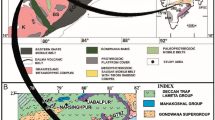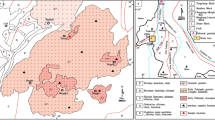Abstract
A 10.35-m-long sediment core from the Luobei depression in Lop-Nur, Xinjiang, Northwest China, provides detailed information about environmental changes during the Late Pleistocene. The samples taken every 5 cm of the core were analyzed for 10 environmental proxies, including magnetic susceptibility, granularity, chroma, carbonate and loss on ignition (LOI), and pH value. The chronology data are provided by the uranium/thorium disequilibrium dates. The sediments of the section were deposited during the last 32000 years. The results of analysis of 10 proxies were examined using multivariate statistical analysis, and the principal components were calculated. According to the results, the Late Pleistocene sequence contains four climatic and environmental stages appearing in the cycles of cold-wet and warm-dry changes. During 10-9 ka BP, it was the earliest warm episode in the Holocene. Environmental changes in this district were restricted by global change, as suggested by the analysis of glacial-interglacial cycles. But it was different from the mutative trend of a monsoon region in East China because of its own characteristics, which was the situation of cold-wet and warm-dry climate-environment change. The candidate reason may be the uplift of the Tibet Plateau and the westerly wind circulation.
Similar content being viewed by others
References
Chen Jing’an, Wan Guojiang, Wang Fushun, Huang Ronggui, and Zhang Feng (2002) The carbon records of the sediments in modern lakes [J]. Science in China (Series D). 32, 73–80 (in Chinese).
Chen Jing’an, Wan Guojiang, Zhang Feng, Daviddian Zhang, and Huang Ronggui (2003) The environmental record of lake sediment in different time scale: as a sample of the granularity of lake sediment [J]. Science in China (Series D). 33, 563–568 (in Chinese).
Gao Donglin, Li Bingxiao, and Shan Fashou (2001) Sedimentary features of Minerals of the CK-2 drill in north of Luobubo salt lake, Xinjiang Province [J]. Journal of Salt Lake Research. 19, 53–54 (in Chinese with English abstract).
Han Shuti and Li Zhizhong (1994) The accumulating regulation of deposit geochemistry of Balikun Lake, Xinjiang [J]. Oceanologia et Limnologia Sinica. 25, 429–437 (in Chinese with English abstract).
Li Meijun, Ji Yunlong, and Hu Liguo (2003) Geochemical sequence stratigraphy and its application prospect in lake basins [J]. Chinese Journal of Geochemistry. 22, 164–172.
Liu Dongsheng (1997) The Quaternary Environments [M]. Science Press, Beijing (in Chinese).
Luo Chao, Peng Zicheng, Liu Weiguo, and Liu Guijian (2006) The environmental evolution of Lop-Nur area, Xinjiang [J]. Chinese Journal of Nature. 28, 37–41 (in Chinese with English abstract).
Ma Zhibang, Wang Zhenhai, Liu Jiaqi, Yuan Baoyin, Xiao Jule, and Zhang Guoping (2004) U-series chronology of sediments associated with Late Quaternary fluctuations, Balikun Lake, northern China [J]. Quaternary International. 121, 89–98.
Montaggioni L.F. (2005) History of Indo-Pacific coral reef systems since the last glaciation development patterns and controlling factors [J]. Earth Science Review. 71, 1–75.
Peng Zicheng, Liu Weiguo, Zhang Pengxi, Zhang Zhaofeng, and Zhou Jie (2001) Precise timing of lacustrine gypsum in Luobubo, Xinjiang using the thermal ionization mass spectrometry U-series method [J]. Chinese Science Bulletin. 46, 1538–1541.
Rhodes T.E., Gasse F., Lin Ruifen, and Fontes J.C. (1996) A late Pleistoncene-Holocence lacustrine record from Lake Manas, Zunggur (northern Xinjiang, western China) [J]. Paleogeography, Paleoclimatology, Palaecology. 120, 105–121.
Wang Yunfei (1993) The carbonate sedimentation and environmental change in Daihai Lake [J]. Oceanologia et Limnologia Sinica. 24, 31–35 (in Chinese with English abstract).
Wang Zhaorong, Yuan Daoxian, Lin Yushi, Zhang Meiliang, Zhou Jie, and Liu Weiguo (2001) High-resolution dating of stalagmites and reconstruction of paleo-environments [J]. Chinese Journal of Geochemistry. 20, 282–288.
Wu Yanhong and Li Shijie (2004) Significance of lake sediment color for short time scale climate variation [J]. Advances in Earth Sciences. 19, 789–792 (in Chinese with English abstract).
Yang Xiaoping, Zhu Zhenda, Jaekel D., Owen L.A., and Han Jiamao (2002) Late Quaternary Palaeoenvironment change and landscape evolution along the Keriya River, Xinjiang, China: The relationship between high mountain glaciation and landscape evolution in foreland desert regions [J]. Quaternary International. 97–98, 155–166.
Yu Lizhong, Xu Yu, and Xu Shiyuan (1995) Study on the magnetism of lake sediment and its application to the environment. In Geologic Experiment and Simulation [M]. pp.305–314. Earthquake Press, Beijing (in Chinese).
Yuan Guoying and Yuan Lei (1998) An approach to the environmental changes in Lop-Nur history [J]. Acta Geographica Sinica. 53, 83–89.
Zhang Enlou, Shen Ji, Wang Suming, Xie Weilan, and Jin Zhangdong (2002) Climate and Environment Change during the Past 900 years in Qinghai lake [J]. Journal of Lake Sciences. 14, 32–38 (in Chinese with English abstract).
Zhang Zhenke and Wang Suming (1999) Advance and prospects of lake sediments and environmental changes study in China [J]. Advances in Earth Sciences. 14, 417–422 (in Chinese with English abstract).
Zhao Shencai (2005) The environmental evolvement of The Lop-Nur and the development of western arid district [J]. Advances in Earth Sciences. 20, 920–923 (in Chinese with English abstract).
Zhong Wei and Xiong Heigang (1998) Preliminary study on spore-pollen combination and paleoenvironmental features of the Holocence lacustrine sediment, Bosten Lake [J]. Journal of Xinjiang University. 3, 84–88 (in Chinese with English abstract).
Author information
Authors and Affiliations
Corresponding author
Rights and permissions
About this article
Cite this article
Luo, C., Yang, D., Peng, Z. et al. Multi-proxy evidence for Late Pleistocene-Holocene climatic and environmental changes in Lop-Nur, Xinjiang, Northwest China. Chin. J. Geochem. 27, 257–264 (2008). https://doi.org/10.1007/s11631-008-0257-1
Received:
Accepted:
Published:
Issue Date:
DOI: https://doi.org/10.1007/s11631-008-0257-1




